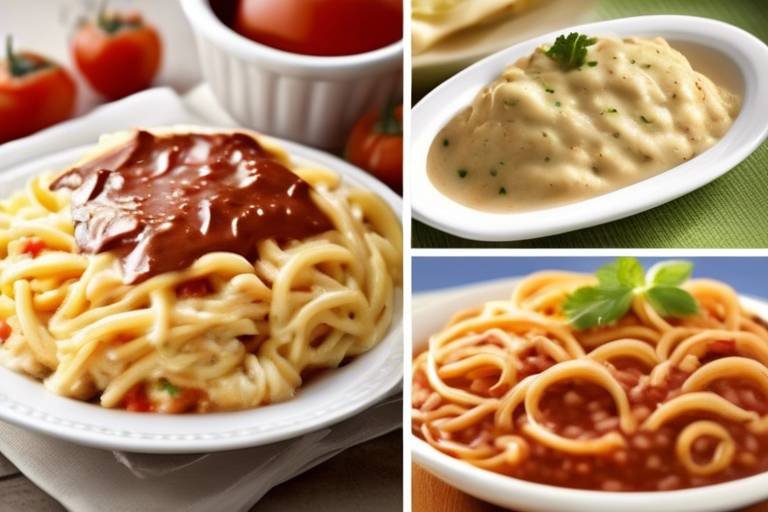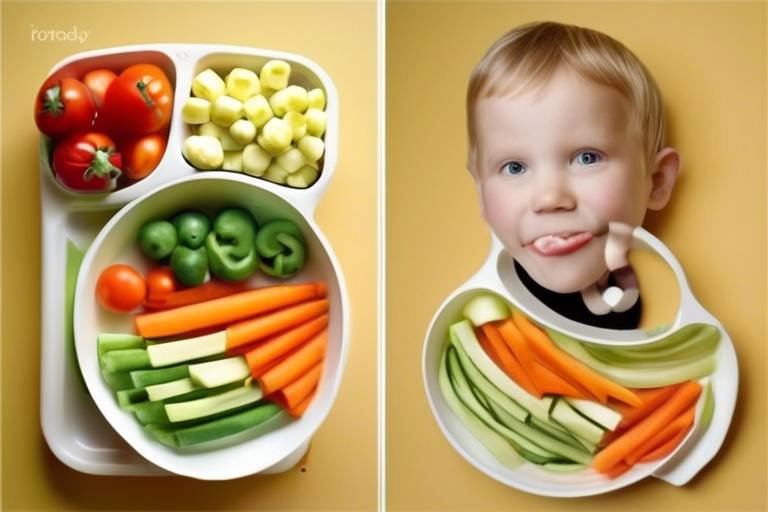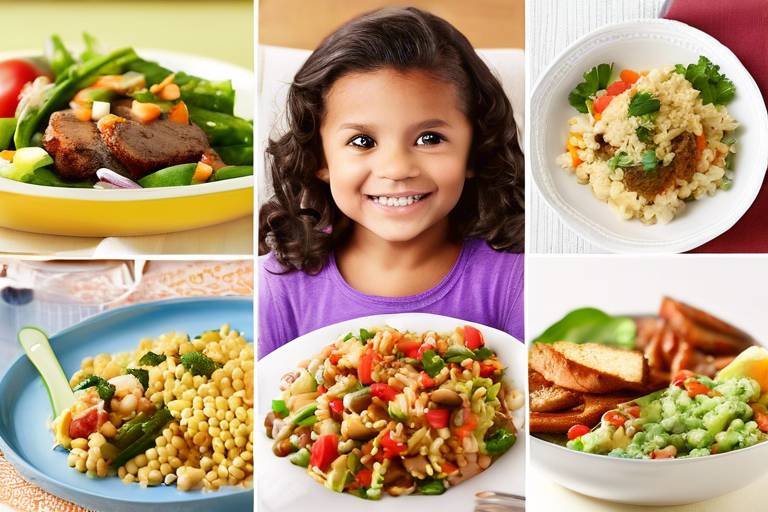Family Nutrition: Making Mealtime Fun
In today's fast-paced world, where schedules are packed and distractions abound, making mealtime a cherished family ritual can feel like an uphill battle. But what if I told you that transforming your dining experience could not only enhance your family's nutrition but also strengthen your bonds? That's right! By making mealtime fun and engaging, you can create an environment where healthy eating habits flourish. Imagine gathering around the table, sharing stories, laughter, and delicious food that everyone loves. Sounds appealing, doesn't it? Let’s dive into the ways you can make this a reality!
Regular family meals are more than just a way to fill bellies; they are a cornerstone of a healthy lifestyle. When families sit down together, they not only enjoy nutritious food but also build emotional connections. Studies have shown that families who dine together tend to have a more balanced diet, rich in fruits, vegetables, and whole grains. But why is this important? Well, shared dining experiences foster communication, encourage children to try new foods, and help develop a sense of belonging. So, let's make it a point to prioritize family meals, not just for the food but for the invaluable time spent together.
Now that we understand the importance of family meals, let’s talk about the fun part—food! Discovering creative and nutritious recipes that cater to everyone’s tastes can be a game changer. Think colorful stir-fries bursting with veggies, or homemade tacos where each family member can customize their toppings. The key is to make cooking a collaborative effort. When everyone contributes to the meal, it not only tastes better but also creates a sense of ownership and excitement. Here are a few ideas to get you started:
- Rainbow Veggie Stir-Fry: A mix of colorful vegetables sautéed with lean protein and served over brown rice.
- Build-Your-Own Tacos: Set up a taco bar with various toppings like beans, cheese, salsa, and guacamole.
- Homemade Pizzas: Let everyone create their own pizza using whole wheat dough and a variety of toppings.
One of the best ways to make mealtime more enjoyable is by involving your kids in the cooking process. Not only does this make them more excited about the food they eat, but it also teaches them essential cooking skills. Imagine your little one proudly declaring that they made the salad or mixed the batter for the cookies! This engagement fosters creativity and encourages them to experiment with flavors and ingredients. Plus, it’s a fantastic opportunity for you to sneak in some nutrition education while having fun together in the kitchen.
Let’s spice things up with some fun cooking techniques! Kids love hands-on activities, so why not make homemade pizzas where they can spread the sauce and sprinkle the cheese? Or how about decorating cupcakes with colorful icing and sprinkles? These activities not only teach cooking skills but also allow for creativity to flow. Cooking can be a delightful adventure, and when children are involved, they are more likely to try new things. Who knew that a simple pizza night could turn into a culinary masterpiece?
Assigning age-appropriate cooking tasks can empower your children and boost their confidence in the kitchen. For instance:
| Age Group | Cooking Tasks |
|---|---|
| 2-4 years | Washing fruits and vegetables |
| 5-7 years | Mixing ingredients and measuring |
| 8-12 years | Chopping vegetables with supervision |
| 13+ years | Preparing full meals independently |
This table illustrates how you can engage children at various ages, ensuring that they feel included while also keeping safety in mind. The more involved they are, the more likely they are to enjoy healthy foods!
Education is key when it comes to making informed food choices. Teaching your family about nutrition doesn’t have to be a chore; it can be a fun and interactive experience. Consider creating a family nutrition night where you explore different food groups, read labels, and discuss the benefits of various nutrients. You can even make it a game! For example, challenge each family member to find the healthiest snack in the pantry or create a balanced meal using a set list of ingredients. This not only fosters knowledge but also encourages teamwork.
Let’s face it—dealing with picky eaters can be a real challenge. But fear not! There are practical strategies that can help encourage children to try new foods and expand their palates. One effective approach is to incorporate hidden veggies into their favorite meals. For instance, blending spinach into a smoothie or adding finely chopped carrots to spaghetti sauce can make a world of difference. It’s all about being creative and sneaky in a fun way!
Learning how to sneak in vegetables without compromising taste can be a lifesaver for parents. Here are some creative ideas:
- Veggie Purees: Use pureed vegetables in sauces or soups.
- Fruit Smoothies: Blend fruits with spinach or kale for a nutritious drink.
- Cheesy Cauliflower Mash: Substitute some potatoes with cauliflower for a creamy side dish.
Finally, creating a positive mealtime atmosphere is crucial for fostering healthy eating habits. Set the table nicely, turn off the TV, and encourage open communication. Share stories from your day and ask your children about theirs. When meals are associated with warmth and joy, kids are more likely to embrace healthy foods. Remember, mealtime is not just about eating; it’s about connecting with each other. So, let’s make it count!
Q: How often should families eat together?
A: Ideally, families should aim to have at least three meals together each week to strengthen bonds and promote healthy eating habits.
Q: What if my child refuses to eat vegetables?
A: Try incorporating veggies into meals in creative ways, such as blending them into smoothies or hiding them in sauces. Encourage them to help with cooking to increase their interest.
Q: How can I make cooking a fun experience for my kids?
A: Include them in the cooking process by assigning age-appropriate tasks, using fun cooking techniques, and letting them experiment with flavors and ingredients.
Q: What are some easy recipes for busy families?
A: Quick recipes like stir-fries, tacos, and homemade pizzas are great options. They allow for customization and can be prepared in a short amount of time.

Importance of Family Meals
Gathering around the dinner table for family meals is more than just a routine; it's a foundation for building strong relationships and fostering a sense of belonging. When families share meals, they create lasting memories that go beyond the food itself. Studies have shown that regular family meals can significantly enhance emotional well-being and contribute to healthier eating habits. But why is this so important?
First and foremost, family meals provide an opportunity for communication. In our fast-paced lives, it's easy to get caught up in individual schedules, leaving little time for meaningful conversations. However, mealtimes serve as a natural setting for everyone to reconnect, share experiences, and discuss their day. This regular interaction can strengthen family bonds and improve overall emotional health.
Moreover, the nutritional benefits of family meals cannot be overstated. When families eat together, they are more likely to consume a balanced diet rich in fruits, vegetables, and whole grains. According to research, children who regularly participate in family meals have a higher intake of essential nutrients and are less likely to engage in unhealthy eating behaviors. Here’s a quick breakdown of the benefits:
| Benefit | Description |
|---|---|
| Strengthens Relationships | Regular meals foster open communication and deepen family ties. |
| Promotes Healthy Eating | Families are more likely to choose nutritious foods when dining together. |
| Encourages Better Behavior | Children who have family meals tend to exhibit fewer behavioral issues. |
| Improves Academic Performance | Regular family meals are linked to better grades and school performance. |
In addition to these benefits, family meals can also serve as a teaching moment. Parents can use this time to educate their children about nutrition, cooking skills, and even table manners. Involving kids in meal preparation can spark their interest in healthy eating and empower them to make better food choices as they grow.
So, the next time you're tempted to skip a family meal for convenience, think again! The importance of gathering around the table goes far beyond just filling our bellies. It’s about creating a nurturing environment where everyone feels valued and connected. Whether it's a simple weeknight dinner or a festive holiday gathering, the act of sharing a meal together is a powerful way to cultivate love, understanding, and health within the family unit.

Creative Recipe Ideas
When it comes to family meals, creativity is key! Making mealtime fun and engaging can transform the way your family approaches food. Think about it: how often do we get stuck in a rut, preparing the same dishes over and over again? By introducing , you can not only spice up your menu but also encourage healthy eating habits among your family members. Here are some exciting and nutritious recipes that cater to various tastes and dietary needs, ensuring that everyone at the table finds something they love.
One fantastic idea is to create a DIY Taco Night. Set up a taco bar with an assortment of toppings and fillings. You can include options like seasoned ground turkey, black beans, grilled chicken, or sautéed veggies. Add a variety of toppings such as shredded cheese, lettuce, diced tomatoes, guacamole, and salsa. This not only makes the meal interactive but also allows each family member to customize their taco to their liking. Plus, it’s a great way to sneak in some extra vegetables!
Another crowd-pleaser is the Homemade Pizza Party. Who doesn’t love pizza? Instead of ordering out, gather your family and make it together. Use whole wheat dough for a healthier base, and let everyone choose their favorite toppings. Set out bowls with tomato sauce, mozzarella cheese, pepperoni, bell peppers, onions, and olives. Not only does this encourage creativity, but it also allows kids to experiment with different flavors, making them more open to trying new things.
For those looking to add more fruits and veggies into their meals, consider making Rainbow Smoothie Bowls. These vibrant bowls are not only visually appealing but are also packed with nutrients. Start with a base of blended bananas and spinach, then top with an array of colorful fruits like strawberries, blueberries, and kiwi. Sprinkle some granola and chia seeds on top for added crunch. This is a fun way to get kids involved in the kitchen, and it’s a delightful breakfast or snack option that feels like a treat!
Don't forget about incorporating family-friendly salads into your meals. Create a “salad bar” where everyone can choose their ingredients. Offer a variety of greens, proteins (like grilled chicken or chickpeas), colorful veggies, nuts, seeds, and dressings. This not only makes salads more appealing but also encourages your family to explore different flavors and textures. Plus, it’s a great opportunity to talk about the nutritional benefits of each ingredient!
To make things even more exciting, why not try a Cooking Challenge? Set a timer and see who can come up with the most creative dish using a set list of ingredients. This not only adds an element of fun but also encourages teamwork and communication. You can even have a taste test at the end and vote on the best dish. This way, everyone is involved, and it turns cooking into a memorable family event!
As you can see, there are countless ways to make mealtime fun and engaging. By incorporating creative recipes and involving everyone in the cooking process, you can foster a love for healthy eating that lasts a lifetime. So, roll up your sleeves, gather your family, and start experimenting in the kitchen!
Q: How can I get my kids to eat more vegetables?
A: Involve them in the cooking process and let them choose their veggies. You can also sneak them into dishes like smoothies, sauces, and baked goods.
Q: What are some quick and easy meal ideas for busy families?
A: Consider one-pot meals, sheet pan dinners, or slow cooker recipes that can be prepared in advance. Tacos and homemade pizzas are also quick to assemble!
Q: How can I make healthy eating more appealing to my family?
A: Get creative with presentation! Use colorful ingredients, fun shapes, and interactive meals to make healthy eating exciting.

Involving Kids in Cooking
Getting kids involved in the kitchen can be a game-changer for family meals. Not only does it make cooking more fun, but it also teaches children essential life skills that they will carry with them into adulthood. Imagine your little ones, apron-clad, stirring a pot or rolling out dough, their faces lighting up with excitement as they create something delicious. This experience can transform mealtime from a mundane chore into a cherished family activity.
When children participate in cooking, they develop a sense of ownership over their meals. They are more likely to try new foods when they have had a hand in preparing them. Plus, it’s a fantastic opportunity to sneak in some nutrition education. You can discuss the different ingredients, where they come from, and their health benefits while you whip up a tasty dish. For example, while making a colorful salad, you can talk about the importance of eating a variety of vegetables and how each one contributes to a healthy diet.
To make the cooking process engaging, you can introduce a few fun cooking techniques. Kids love to be creative, so why not let them decorate their own pizzas or cupcakes? This not only allows them to express themselves but also teaches them about portion control and the balance of flavors. You could set up a mini pizza-making station with various toppings laid out, allowing each child to customize their pizza masterpiece. It’s a delightful way to spark their imagination and make them feel like culinary artists!
Assigning age-appropriate tasks is crucial to keeping kids engaged and safe in the kitchen. For younger children, simple tasks like washing vegetables or stirring batter can be both fun and educational. As they grow older, they can take on more complex responsibilities, such as measuring ingredients or following a recipe. Here’s a quick breakdown of tasks based on age groups:
| Age Group | Cooking Tasks |
|---|---|
| 3-5 years | Washing fruits and vegetables, tearing lettuce, stirring ingredients |
| 6-8 years | Measuring ingredients, spreading sauces, assembling sandwiches |
| 9-12 years | Chopping soft vegetables with supervision, following simple recipes, baking |
| 13 years and up | Cooking on the stove, using kitchen appliances, meal planning |
Involving kids in cooking not only makes mealtime more enjoyable but also fosters a sense of collaboration and teamwork within the family. It’s a wonderful way to create lasting memories and traditions that can be passed down through generations. So, roll up those sleeves, tie on those aprons, and get ready to whip up some culinary magic together!
- Why is it important to involve kids in cooking? Involving kids helps them develop cooking skills, encourages them to try new foods, and fosters family bonding.
- What age is appropriate to start involving kids in cooking? You can start as early as 3 years old, with simple tasks, and gradually increase their responsibilities as they grow.
- How can I make cooking fun for my kids? Introduce creative recipes, fun cooking techniques, and allow them to personalize their meals.

Fun Cooking Techniques
Cooking with your family can be a thrilling adventure, especially when you incorporate that ignite creativity and excitement in the kitchen. Imagine transforming a mundane meal prep into a delightful experience! One of the most engaging ways to do this is by allowing everyone to take part in making their own dishes. For instance, making homemade pizzas is not only delicious but also a fantastic way for family members to express their culinary flair. You can set up a pizza station with various toppings—think colorful vegetables, different cheeses, and a variety of sauces. This not only makes the meal more interactive but also encourages kids to try new ingredients they might otherwise shy away from.
Another exciting technique is decorating cupcakes. This can turn an ordinary dessert into a masterpiece! Set out bowls of frosting, sprinkles, and fruits, and let everyone unleash their inner artist. Not only does this make baking fun, but it also provides a chance for kids to learn about portion sizes and the importance of balancing indulgent treats with healthier options. Plus, who doesn’t love a sweet reward for their hard work?
To make the cooking experience even more enjoyable, consider introducing themed cooking nights where each family member gets to choose a theme or cuisine. One week, you might dive into Mexican night with tacos and guacamole, while the next could be all about Italian cuisine with pasta and tiramisu. This not only broadens everyone’s culinary horizons but also sparks discussions about different cultures and their foods, making mealtime educational as well as enjoyable.
Don’t forget about the power of cooking challenges. These can be as simple as timing each other to see who can chop vegetables the fastest or creating a dish using a mystery ingredient from the pantry. Such challenges can foster teamwork and healthy competition, all while enhancing cooking skills. And let’s be honest, who wouldn’t want to show off their culinary prowess?
Incorporating these fun cooking techniques can transform your family’s approach to meals. Instead of viewing cooking as a chore, it becomes an exciting opportunity for bonding, learning, and creativity. So roll up those sleeves, put on your aprons, and get ready to make unforgettable memories in the kitchen!
Q: How can I get my kids interested in cooking?
A: Start with fun and interactive recipes that allow them to express their creativity, such as homemade pizzas or cupcake decorating. Involving them in the cooking process makes it more enjoyable and educational.
Q: What are some easy recipes for family cooking nights?
A: Simple recipes like tacos, pasta, and homemade burgers are great options. They allow for customization and can cater to different tastes and dietary preferences.
Q: How do I encourage my picky eater to try new foods?
A: Involve them in the cooking process, and try incorporating hidden veggies into their favorite meals. Making cooking a fun activity can help them be more open to trying new things.

Age-Appropriate Tasks
When it comes to involving children in the kitchen, assigning is crucial for both their safety and confidence. Each age group can contribute in meaningful ways, turning cooking into a fun and educational experience. For instance, toddlers can assist by washing fruits and vegetables, which not only helps them feel included but also teaches them about cleanliness and food preparation. As they grow, their responsibilities can expand. Here’s a quick breakdown of tasks suitable for various age groups:
| Age Group | Suggested Tasks |
|---|---|
| 2-4 years |
|
| 5-7 years |
|
| 8-12 years |
|
| 13 years and up |
|
This breakdown not only helps parents assign tasks effectively but also ensures that kids are engaged and learning at their own level. For example, when a 5-year-old spreads sauce on a homemade pizza, they’re not just having fun; they’re also developing fine motor skills and gaining a sense of accomplishment. As children progress to the 8-12 age range, they can start to take on more complex tasks that require critical thinking and problem-solving skills, like following a recipe or preparing a simple dish.
Moreover, involving children in cooking fosters a sense of responsibility and encourages them to take pride in their contributions. It’s a fantastic way to bond as a family, with shared laughter and learning moments that can create lasting memories. So, why not roll up your sleeves and dive into the culinary world together? The kitchen can be a playground for creativity, and by assigning age-appropriate tasks, you’re setting the stage for a lifetime of healthy eating habits and joyful cooking experiences!
Q: At what age can my child start helping in the kitchen?
A: Children can begin helping in the kitchen as early as 2 years old with simple tasks like washing fruits and setting the table. As they grow, you can gradually introduce more complex tasks.
Q: How do I ensure my child's safety while cooking?
A: Always supervise younger children closely, provide age-appropriate tasks, and teach them about kitchen safety, such as handling knives and using the stove.
Q: What are some fun recipes to try with kids?
A: Some fun recipes include homemade pizzas, decorating cupcakes, or assembling their own sandwiches. These activities allow for creativity while also encouraging healthy eating.

Nutrition Education for Families
Understanding nutrition is crucial for families who want to make informed food choices that promote health and well-being. Teaching family members about nutrition can be as engaging as it is educational. Imagine sitting around the dinner table, discussing not just what’s on the plate but also where it came from and how it benefits our bodies. This approach not only fosters a deeper appreciation for food but also encourages healthier eating habits. So, how can we effectively educate our families about nutrition?
First off, it’s important to make nutrition education relatable. Start by involving everyone in the grocery shopping process. When you go to the supermarket, turn it into a fun scavenger hunt. Challenge your kids to find fruits and vegetables of different colors or to pick out a new healthy snack. This way, they learn to identify healthy options while having fun. You can even create a colorful chart together at home to track the different fruits and veggies they’ve tried. This visual representation can spark curiosity and encourage them to try more.
Another effective method is to incorporate nutrition education into cooking sessions. When preparing a meal, take a moment to explain the nutritional benefits of each ingredient. For example, while chopping broccoli, you might say, “Did you know that broccoli is packed with vitamins C and K? It helps keep our immune system strong!” This not only makes the cooking process more interactive but also instills a sense of pride in preparing healthy meals. Kids often feel more inclined to eat something they’ve helped create.
Furthermore, consider organizing family cooking nights where everyone contributes to the meal. Each family member can take turns choosing a recipe that incorporates healthy ingredients, creating a sense of ownership in the meal preparation. You can even turn it into a friendly competition by having each person present their dish and explain its nutritional benefits. This not only promotes creativity but also reinforces the concept of balanced meals.
To further enhance your family’s nutrition education, utilize resources such as online cooking classes or nutrition workshops. Many local community centers and health organizations offer free or low-cost sessions that can provide valuable insights into healthy eating. Additionally, there are numerous websites and apps dedicated to teaching families about nutrition in a fun and interactive way. For example, ChooseMyPlate.gov provides tips on portion sizes and food groups, making it easier to understand how to build a balanced plate.
Lastly, keep the conversation about nutrition ongoing. Make it a regular topic during family discussions. Ask questions like, “What healthy foods did you try today?” or “How do you think we can make our meals even healthier?” This kind of dialogue not only normalizes discussions about food but also empowers family members to think critically about their dietary choices.
In summary, nutrition education for families is not just about teaching facts; it’s about creating a culture of health and wellness. By making learning interactive and enjoyable, you can inspire your family to embrace healthy eating habits that last a lifetime. Remember, the goal is to turn nutrition into a fun adventure rather than a chore!
- Why is nutrition education important for families?
Nutrition education helps families make informed food choices, promotes healthier eating habits, and fosters a greater appreciation for food. - How can I involve my kids in nutrition education?
Involve your kids in grocery shopping, cooking, and meal planning to make learning about nutrition fun and engaging. - What resources can I use for nutrition education?
Look for online cooking classes, nutrition workshops, and educational websites like ChooseMyPlate.gov for valuable information.

Strategies for Picky Eaters
Dealing with picky eaters can sometimes feel like navigating a minefield. You want your child to eat healthy, but they seem to have an aversion to anything that’s green or slightly unfamiliar. The good news is that you’re not alone in this struggle, and there are effective strategies to encourage your little ones to broaden their culinary horizons. Think of it as a culinary adventure, where the goal is to discover new flavors together!
One of the first steps is to create a positive mealtime atmosphere. When meals feel like a chore, kids are less likely to try new foods. Make it a family affair! Share stories, play soft music, or even create a theme for the meal. For instance, if you’re having Italian night, play some Italian tunes and talk about your favorite Italian dishes. This sets a relaxed tone that encourages experimentation with food.
Another effective strategy is to involve your children in meal preparation. When kids help cook, they often become more interested in eating what they’ve made. Let them wash veggies, sprinkle cheese, or mix ingredients. You could even create a weekly 'Chef Night' where each child gets to choose a recipe and help prepare it. Not only does this foster a sense of accomplishment, but it also gives them the chance to explore new ingredients in a fun way.
Additionally, consider incorporating hidden vegetables into meals. This doesn’t mean you have to resort to sneaky tactics; rather, it’s about being creative! For example, you can blend spinach into a smoothie or add finely grated carrots to spaghetti sauce. The key is to enhance the dish without compromising on flavor. Here’s a quick table to illustrate some ideas:
| Dish | Hidden Veggie | Preparation Method |
|---|---|---|
| Spaghetti Sauce | Carrots, Zucchini | Finely grated or pureed |
| Mac and Cheese | Cauliflower | Steamed and blended into cheese sauce |
| Smoothies | Spinach, Kale | Blend with fruits |
Another approach is to introduce new foods alongside familiar favorites. For instance, if your child loves chicken nuggets, pair them with a new dipping sauce made from yogurt and herbs. This way, the familiar item acts as a safety net while they explore the new flavor. It’s all about making the experience less intimidating and more inviting.
Lastly, be patient and persistent. It’s not uncommon for children to need to be exposed to a new food several times before they’re willing to try it. Keep offering the food without pressure. Remember, the goal is to create a relaxed environment where they feel safe to explore new tastes. Over time, they may surprise you with their willingness to try something new!
Q: What should I do if my child refuses to eat vegetables?
A: Try introducing vegetables in different forms, such as smoothies, dips, or as part of a favorite dish. Involving them in cooking can also spark interest.
Q: How can I encourage my child to try new foods?
A: Encourage them to taste new foods by making it a game or challenge. You can use fun names for the foods or create a “taste test” night.
Q: Is it okay to bribe my child to eat healthy foods?
A: While it may seem tempting, using bribes can create a negative association with healthy foods. Instead, focus on positive reinforcement and celebrate small victories.

Incorporating Hidden Veggies
Getting kids to eat their vegetables can sometimes feel like trying to pull teeth—frustrating and often met with resistance! But what if I told you that there’s a sneaky way to incorporate those nutritious greens into meals without the usual fuss? into your family's diet can be a game-changer, transforming mealtime battles into delightful culinary adventures.
One of the best strategies is to blend vegetables into sauces, smoothies, and baked goods. For instance, you can add pureed spinach or kale to a fruit smoothie. Not only does it boost the nutritional value, but the vibrant colors and sweet flavors of the fruits often mask the taste of the greens. Your kids will be sipping on a delicious treat while unknowingly consuming a serving of veggies!
Another fun idea is to turn vegetables into creative shapes. Kids are naturally drawn to fun and whimsical presentations. Use cookie cutters to create star-shaped cucumbers or animal-shaped bell peppers. This simple trick can make veggies more appealing and encourage your little ones to munch on them without a second thought.
Don’t forget about the power of incorporating veggies into familiar favorites. You can sneak shredded carrots or zucchini into meatballs, tacos, or even pancakes! Here’s a quick table showcasing some popular dishes and suggested hidden veggie additions:
| Dish | Hidden Veggie Addition |
|---|---|
| Spaghetti Sauce | Pureed carrots and bell peppers |
| Mac and Cheese | Pureed cauliflower |
| Brownies | Black bean puree or spinach |
| Pancakes | Grated zucchini or carrots |
Moreover, involving kids in the cooking process can make them more open to trying new things. When they help prepare the meal, they’re more likely to take ownership of their food choices. Try having a “veggie night” where everyone picks a vegetable to incorporate into the meal. This not only makes them excited about eating but also teaches them about the importance of a balanced diet.
Lastly, remember to celebrate the small victories! If your child tries a new vegetable, even if it's just a tiny bite, make a big deal out of it. Positive reinforcement can go a long way in encouraging them to keep exploring different flavors and textures. By making veggies fun and engaging, you’re setting the stage for a lifetime of healthy eating habits.
Q1: How can I hide veggies in meals without my kids noticing?
A1: One effective method is to puree vegetables and mix them into sauces, soups, or smoothies. You can also incorporate finely grated or shredded vegetables into dishes like meatballs, tacos, and baked goods.
Q2: Are there specific vegetables that are easier to hide than others?
A2: Yes! Vegetables like spinach, zucchini, and carrots are great options because they can be easily blended or grated. They have mild flavors that can be masked by stronger ingredients.
Q3: What if my child refuses to eat vegetables altogether?
A3: It's important to be patient and persistent. Try involving them in cooking, presenting veggies in fun shapes, and offering a variety of cooking methods. Sometimes, it takes multiple exposures before they’re willing to try something new.

Creating a Positive Mealtime Atmosphere
Creating a positive mealtime atmosphere is essential for fostering healthy eating habits and strengthening family bonds. Imagine sitting around a table filled with delicious food, laughter echoing through the air, and everyone sharing stories about their day. Sounds perfect, right? Well, it can be! The key is to cultivate an environment where everyone feels comfortable and engaged. Start by setting the table in a way that feels special; use colorful plates, fun napkins, and maybe even a centerpiece that reflects the season. This small act can transform an ordinary meal into a memorable occasion.
Moreover, it's important to establish some ground rules for mealtime conversations. Encourage open discussions while avoiding negative topics that could dampen the mood. Instead, focus on sharing highlights of the day, funny anecdotes, or even discussing a topic of interest. This not only makes meals more enjoyable but also strengthens family connections. You might even consider implementing a "question of the day" tradition, where each family member takes turns asking something fun or thought-provoking. This can lead to engaging discussions and help everyone feel included.
Another vital aspect of creating a positive atmosphere is to minimize distractions. Turn off the television, put away phones, and focus on each other. In our fast-paced world, mealtime can be a rare opportunity to connect. By eliminating distractions, you allow space for genuine interactions. You might be surprised at how much more you learn about each other when you’re fully present. Remember, the goal here is to enjoy the meal and each other's company, not just to fill your stomachs!
Lastly, consider incorporating fun and interactive elements into your meals. For example, you can set up a taco bar where everyone can customize their own tacos or have a pizza night where family members can choose their toppings. This not only makes the meal more enjoyable but also encourages creativity and collaboration. Kids especially love being involved in the meal preparation process, and it can be a great way to teach them about nutrition in a fun manner.
In summary, a positive mealtime atmosphere is about more than just the food on the table; it’s about the connections we build and the memories we create together. By focusing on engaging conversations, minimizing distractions, and incorporating fun meal elements, you can transform mealtime into a cherished family tradition that everyone looks forward to.
- How can I encourage my kids to participate in mealtime? Start by involving them in meal planning and preparation, making it a fun and collaborative process.
- What if my family is busy and we can't eat together often? Try to schedule at least one family meal a week where everyone can come together, even if it's just for a quick dinner.
- How do I handle disagreements during meals? Set ground rules for respectful conversations and remind everyone that mealtime is about enjoying each other's company.
Frequently Asked Questions
-
Why are family meals important?
Family meals are essential because they not only strengthen family bonds but also promote healthier eating habits. Sharing meals creates an opportunity for conversation and connection, which can enhance emotional well-being. Plus, studies show that families who eat together tend to have better nutritional balance!
-
How can I make mealtime fun for my kids?
Making mealtime fun can be as simple as involving your kids in the cooking process! Let them help choose recipes, measure ingredients, or even decorate their plates. You can also introduce exciting cooking techniques like making homemade pizzas or decorating cupcakes to keep them engaged and excited about food!
-
What are some creative recipe ideas for families?
There are countless creative recipes you can try! Think of colorful veggie stir-fries, DIY taco bars, or smoothie bowls with various toppings. These recipes are not only nutritious but also allow everyone to customize their meals according to their tastes, making them more enjoyable for the whole family!
-
How can I involve my kids in cooking safely?
Involving kids in cooking can be safe and fun! Assign age-appropriate tasks like washing veggies for younger kids or stirring ingredients for older ones. Always supervise them closely, and teach them about kitchen safety. This not only empowers them but also builds their confidence in the kitchen!
-
What strategies can I use for picky eaters?
Dealing with picky eaters can be tricky, but there are effective strategies! Try incorporating hidden veggies into their favorite dishes, like blending spinach into smoothies or adding grated carrots to pasta sauce. Gradually introducing new foods alongside familiar favorites can also help them expand their palate.
-
How can I create a positive mealtime atmosphere?
To foster a positive mealtime atmosphere, set the table nicely, play some soft background music, and encourage open conversation. Avoid distractions like TV or phones, and focus on enjoying each other's company. This creates an inviting environment where everyone feels comfortable sharing their thoughts and experiences!
-
What are some tips for teaching kids about nutrition?
Teaching kids about nutrition can be fun! Use colorful charts to show food groups, involve them in grocery shopping, and explain the benefits of different foods. You can even turn it into a game by having them identify healthy options at the store. Making it interactive helps them learn while having fun!



















